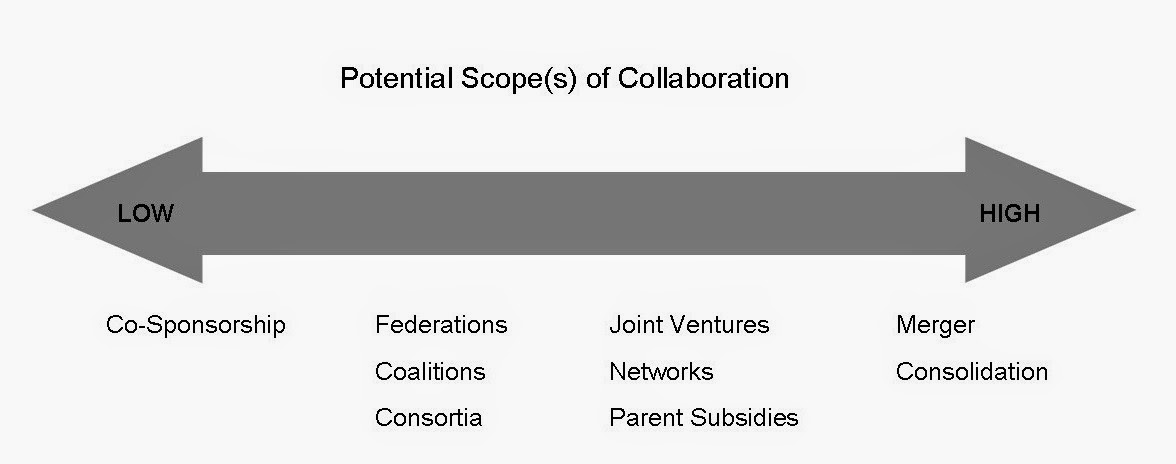Collaboration across organizations is increasingly becoming
a necessity in nonprofit sector as it can improve service delivery and increase
funding potential (Sharma 1998, Yankey 2001).
Collaboration, however, is not a panacea for problems and when
mismanaged can lead to worse outcomes than the partner organizations had on
their own. The three case studies of
Massachusetts Department of Social Services (DSS) and La Alianza, Timberland
and City Year, and First Things First (FTF) and the Seattle Art Museum (SAM) demonstrate
some of the problems that can occur, particularly in collaborations across
sectors, if collaboration is not implemented carefully.
Three key elements to successful collaborative relationship exist:
1.) Know Thyself, Thy
Partner, and thy Environment: Potential collaborators can use strategic planning, SWOT analysis, and side-by-side analysis (pg. 26) ought to determine where
organizations are, where they need to be and what resources can be brought to
the table via collaboration. In addition,
the way that power and responsibilities will be divided must be ascertained at
this time. Collaboration can only
succeed if all partners are equally valued (United Way 2008).
2.) Know the scope: Not all collaborations are equal. The schema below provides a breakdown of how
collaboration can be seen as a spectrum (Yancey 2001). Collaborating organizations need to know
where they are on this spectrum (United Way 2008).
3.) Communication:
Both the analysis and scope must be communicated to potential collaborators and
to all stakeholders (Yancey 2001).
City Year and Timberland, a corporation and nonprofit,
failed to analyze and understand the scope and nature of their
partnership. As such what each
organization meant to the other only became clear when both faced financial
threats. A thorough analysis could have
permitted Timberland to better understand its role as a corporation and whether
or not social engagement was sustainable in the long term. This information could have then been
communicated to City Year, along with the clarification of business needs
within the collaborative model, who could then have decided whether or not
collaboration with Timberland, and the extent of that collaboration, would have
been a good fit.
La Alianza and DSS, unlike the case above, have not cemented
their collaboration and are faced with deciding whether or not to move
forward. Both organizations have crucial
strengths: DSS has a government mandate and La Alianza has reputational
capital. Each organization also faces
threats: DSS is scandal-plagued and La Alianza has financial struggles. Again, as with City Year and Timberland,
both organizations must strategically plan and analyze collaboration with an
eye to the long run. For La Alianza,
this determination means deciding if a public/nonprofit collaborative model and
the increased scope of collaboration that it requires ultimately undermines
their internal vision and external reputation.
Finally, the Seattle collaboration indicates the failure of
communication. Both partners brought
unique assets to the collaboration: SAM had financial capacity and FTF could
provide boots on the ground. Whether or not this is an equitable distribution is debatable, however both elements are
crucial to a Get Out The Vote campaign. Both organizations analyzed the environment and
understood the political reality.
However, while leadership roles between the organizations were well
discussed the contributions of each group were misunderstood by more broadly by
stakeholders within the other group.
Given the cultural gap between the two organizations the strengths of
each group ought to have been constantly communicated along with a broader
reminder of the political realities of the campaign. The referendum represented a “one shot”
moment for each organization’s interest and reminders the negative consequences
of failure could have helped hold together these disparate organizations for
the duration of the collaborative campaign.
Sources
Elias, James. 1996. “Timberland and Community Involvement.” Harvard Business School.
N.A “Funding Seattle’s Art Museum & Low-Income Housing:
The Politics of Interest Groups and Tax Levies. Electronic Hallway Network.
Sharma, Janet and Amanada Massey. 1998. “How I learned to
Stop Griping…and Love Collaboration.” National
Community Service Conference.
United Way 2008. “Best Practices Summary: Collaboration,
Coalition Building and Merger. United Way
Worldwide.
Wilson, Julia and Christine Letts. 1998. “Partners in Child
Protection Services.” Kennedy School of
Government Case Program.
Yankey, John et al. 2001. “Merging Nonprofit Organizations:
The Art and Science of the Deal.” Mendel
Center for Nonprofit Organizations.
